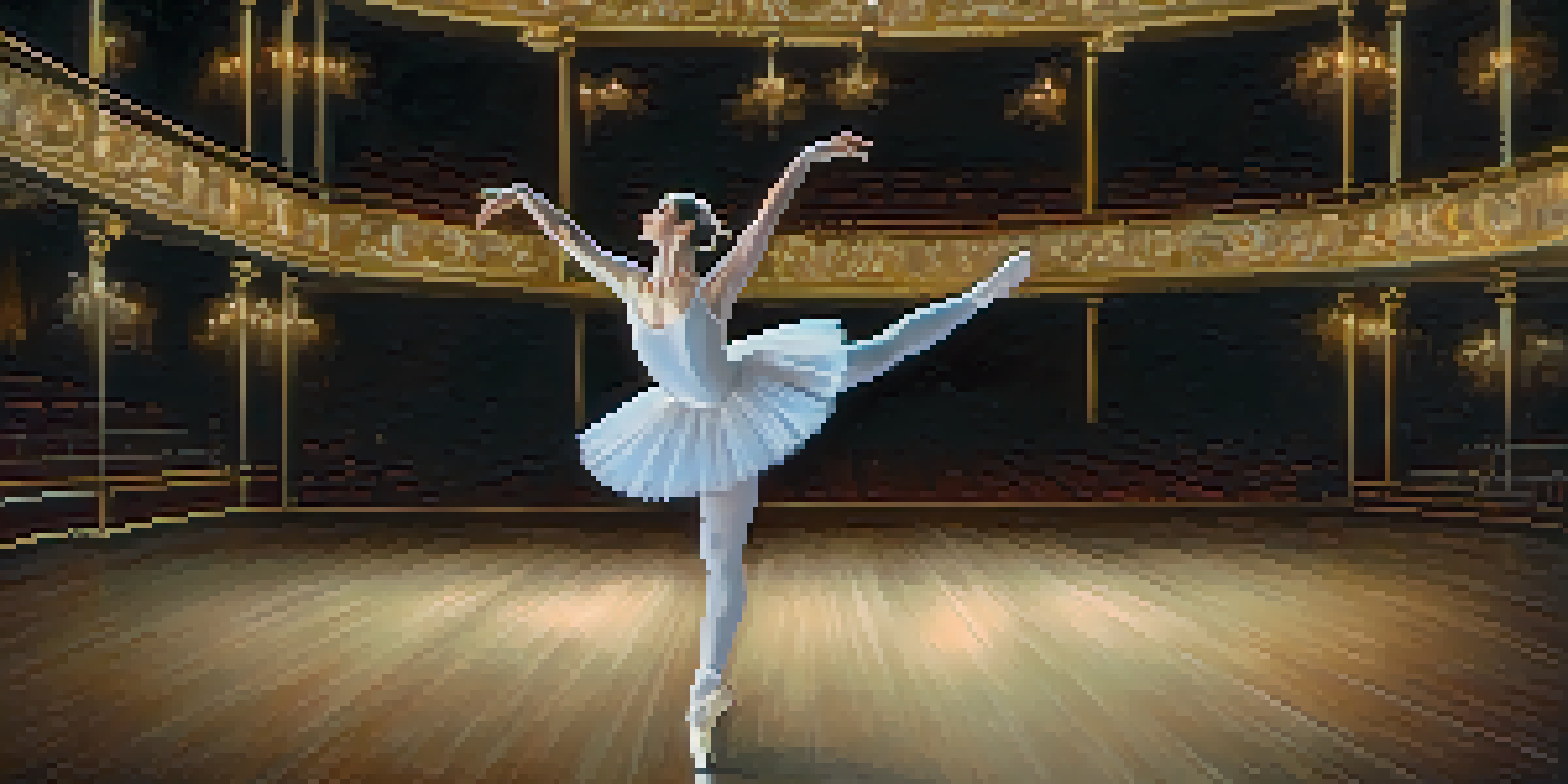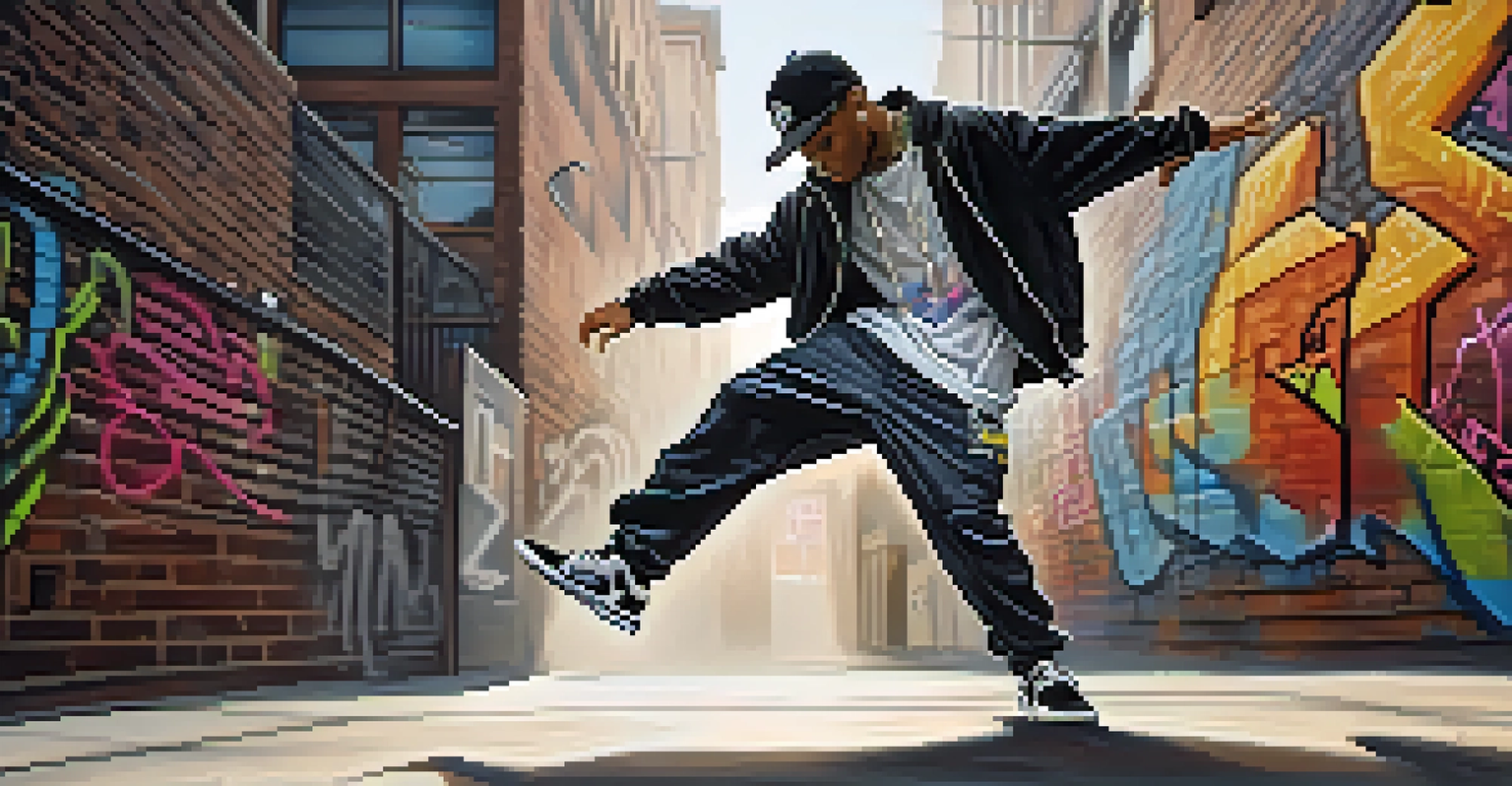Comparative Study of Dance Techniques: Ballet vs. Jazz vs. Hip-Hop

Understanding the Roots: The Origins of Each Dance Style
Ballet, often seen as the foundation of dance, originated in the Italian Renaissance courts of the 15th century. It was later developed in France and Russia, emphasizing grace and technique. On the other hand, jazz dance emerged in the early 20th century, heavily influenced by African American cultural movements and music, making it more spontaneous and expressive.
Dance is the hidden language of the soul.
Hip-hop, born in the 1970s in the Bronx, New York, is a vibrant dance form that encompasses various styles, including breaking, locking, and popping. This genre emphasizes individuality and creativity, often reflecting the social and cultural realities of urban life. Each dance style carries a rich history that informs its techniques and performances.
Related Resource
These origins not only define the movements and techniques but also the cultural significance and emotional expression found within each style. Understanding where these dance forms come from provides a deeper appreciation of their unique characteristics.
The Technique: How Each Style Approaches Movement
Ballet is known for its strict techniques, focusing on posture, alignment, and precise movements. Dancers train for years to master the five basic positions of the feet and the graceful lines of the body. This discipline creates a sense of elegance, often described as 'floating' across the stage.

In contrast, jazz is all about freedom and rhythm. Jazz dancers frequently use improvisation, allowing them to express their personality through the music. This style incorporates strong, quick movements accompanied by catchy rhythms, resulting in a dynamic and lively performance that invites audience engagement.
Dance Styles Have Unique Origins
Each dance style, from ballet to hip-hop, carries a rich history that shapes its techniques and cultural significance.
Hip-hop stands out for its energetic, raw movements and cultural significance. With an emphasis on rhythm and body isolation, hip-hop often reflects the dancer's individuality and can involve freestyle elements. This makes each performance unique, allowing dancers to showcase their creativity within the framework of the style.
Costume and Presentation: The Visual Aspects of Dance
In ballet, the traditional attire consists of tutus, leotards, and pointe shoes, which not only enhance the aesthetic but also support the dancer's technique. The elegance of these costumes complements the graceful movements, creating a visually stunning performance. The overall presentation often includes elaborate sets and lighting to enhance the storytelling aspect.
Ballet is not just a dance; it’s a way of life.
Jazz costumes tend to be more varied and vibrant, reflecting the upbeat nature of the dance. Shiny fabrics, fringe, and bold colors are common, allowing dancers to express themselves freely. The presentation in jazz is often lively and energetic, with an emphasis on connecting with the audience through facial expressions and dynamic movements.
Related Resource
Hip-hop fashion is deeply rooted in street culture, often featuring baggy clothing, sneakers, and accessories that reflect the dancer's personal style. This casual attire allows for greater freedom of movement and aligns with the genre's expressive nature. The presentation is more informal and often includes elements of urban culture, making it relatable and engaging.
Music: The Driving Force Behind Each Dance Style
Ballet is typically accompanied by classical music, which helps set the mood and pace for the performance. The intricate melodies and harmonies complement the technical movements of ballet, creating a harmonious blend of sound and movement. This relationship allows dancers to express emotions and tell stories through their choreography.
Jazz music, with its syncopated rhythms and improvisational elements, provides a lively backdrop for jazz dance. The interplay between the dancers and the music is crucial, as dancers often respond to the beat and the mood of the song. This connection makes jazz performances feel spontaneous and exhilarating, captivating the audience.
Technique Varies by Dance Genre
Ballet emphasizes precision and discipline, while jazz focuses on freedom and rhythm, and hip-hop celebrates individuality and raw expression.
In hip-hop, the beats of rap and electronic music provide a strong foundation for the dance. The heavy bass and rhythmic patterns inspire energetic movements and allow for creative expression. This dance form often involves collaboration between dancers and musicians, resulting in an electrifying performance that resonates with the audience.
Training and Preparation: How Dancers Hone Their Skills
Training in ballet is rigorous and often begins at a young age, focusing on building strength, flexibility, and technique. Dancers typically attend classes multiple times a week and participate in numerous performances, all while adhering to strict training regimens. This dedication is essential for mastering the complex movements and positions required in ballet.
Jazz dancers also undergo extensive training, but the focus is more on creativity and improvisation. Classes often incorporate elements of contemporary dance and theater, encouraging dancers to express themselves and explore their unique styles. This flexibility in training allows for a well-rounded skill set that adapts to various performance opportunities.
Related Resource
Hip-hop training is often more informal, with many dancers learning through community classes, online tutorials, or even from peers. This style encourages individual expression and creativity, making it accessible to a broader audience. Dancers often participate in battles or showcases, further honing their skills in a supportive, collaborative environment.
Performance: The Emotional Connection with the Audience
Ballet performances are often characterized by storytelling, with dancers conveying deep emotions through their movements and expressions. The connection between the dancers and the audience is palpable, as each performance invites viewers to experience the story being told. This emotional depth is a hallmark of ballet, creating a lasting impression.
Jazz performances, on the other hand, emphasize energy and excitement, often engaging the audience through interactive elements. Dancers may use humor, flair, and personal style to connect with viewers, making each performance a unique experience. The lively atmosphere encourages audience participation, enhancing the overall enjoyment of the show.
Costumes Enhance Dance Performances
The visual aspects of dance, including costumes and presentation, play a crucial role in conveying the essence of each style to the audience.
In hip-hop, the emotional connection is rooted in authenticity and individuality. Dancers often share personal stories and experiences through their movements, making the performance relatable and impactful. This genre's emphasis on personal expression fosters a strong bond between the dancer and the audience, leaving a lasting impression long after the performance ends.
Conclusion: Embracing Diversity in Dance Techniques
Each dance style—ballet, jazz, and hip-hop—brings its own unique flavor to the world of dance. While ballet emphasizes technical precision and storytelling, jazz thrives on energy and improvisation, and hip-hop celebrates individuality and raw expression. Together, these styles showcase the beauty of diversity in movement and creativity.
Understanding the differences between these dance techniques not only enriches our appreciation for the art form but also highlights the cultural significance behind each style. By embracing this diversity, we can foster a greater understanding of how dance reflects our shared experiences and emotions.

Ultimately, whether you prefer the elegance of ballet, the vibrancy of jazz, or the authenticity of hip-hop, each style offers a unique way to express oneself and connect with others. Dance is a universal language, inviting everyone to join in and celebrate the joy of movement.